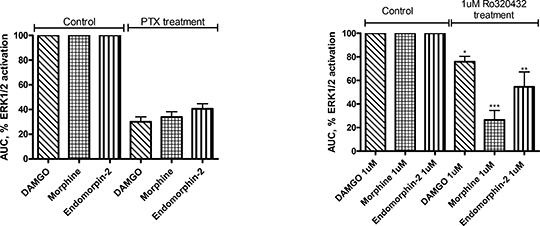PKC inhibition differentially affects ERK activation by µ opioid receptor agonists In the current work the ability of MOPr (µ opioid receptor) ligands displaying different degrees of bias between G-protein and arrestin pathways as well as different efficacies (DAMGO, morphine and endomorphin-2), to induce ERK (extracellular regulated kinase) activation and [35S]GTPγS binding was studied. For ERK activation HEK293-MOPr-expressing cells were pretreated with agonist alone or with a combination of agonist and either PTX or the PKC inhibitor Ro320432. Cell lysates were resolved by SDS-gel electrophoresis and Western blotting. The amount of phosphorylated ERK was monitored by a monoclonal antibody for phosphorylated ERK (P-p-44/42 MAPK anti-rabbit Ab) and was normalized to total ERK using an ERK antibody (p-44/42 MAPK anti-mouse Ab) (1). The area under the curve was determined for each agonist and differences assessed using one-tailed student’s t-test. For [35S]GTPγS binding experiments membranes were prepared using a protocol previously described (2). 
Left hand graph Effect of PTX on ERK1/2 activation by DAMGO, morphine and endomorphin-2 (each 1 uM) Right hand graph Effect of PKC inhibitor RO320432 on ERK1/2 activation by DAMGO, morphine and endomorphin-2 (each 1 uM) Initial experiments indicated that ERK activation peaked at 5-10 min following agonist addition. Following PTX pretreatment (100 ng/ml, overnight), ERK activation was decreased to the same extent (60-70% inhibition) for all three agonists (left hand graph). In membranes [35S]GTPγS binding experiments PTX pretreatment completely inhibited agonist-induced [35S]GTPγS binding. Therefore the remaining agonist-induced ERK activation following PTX treatment must be mediated by a PTX-insensitive G protein, or by another pathway such as one involving arrestins. Pretreatment with the PKC inhibitor Ro320432 (1 µM; 90 min) also inhibited agonist-induced ERK activation, but the extent of the inhibitory effect was agonist-dependent (right hand graph). Whereas DAMGO-induced ERK activation was inhibited by 24% (P<0.05), endomorphin-2-induced activation was inhibited by 45% (P<0.05) and morphine-induced activation by 73%(P<0.05) comparing to control (right hand graph). ERK activation effects of the agonists were inhibited by 1 uM naloxone (P<0.05). These results indicate that although MOPr agonist-induced ERK activation in HEK293 cells is mediated to a large extent through a PTX-dependent pathway, the involvement of PKC varies significantly between the agonists tested. The nature of the PKC pathway involved remains to be determined (since there is little evidence that MOPr is Gq-coupled), whilst these results also raise the possibility that the differential involvement of PKC in agonist-activated ERK may reflect ligand bias. (1) Zheng, H et al (2007). Mol Pharm73(1), 178-190 (2) McPherson, J et al (2010). Mol Pharm78(4), 756-766
|


